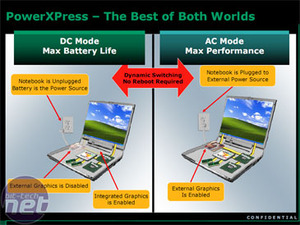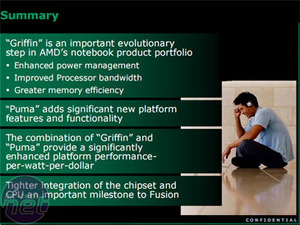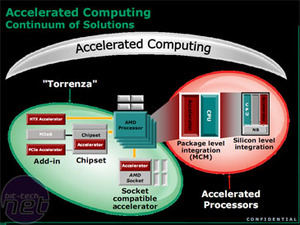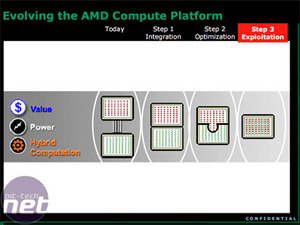RS780M: The Future DirectX 10 Chipset
The AMD 780G builds off of the recently released AMD 690G chipset, and features and updated DirectX 10 graphics core with Blu-Ray and HD-DVD support thanks to the inclusion of the Unified Video Decoder (UVD) from AMD’s recent HD 2000 series graphics cards. However, when we asked about the functionality of this unit in the new IGP, AMD told us that it would have similar but not identical capabilities.Both HyperTransport 3.0 and PCI-Express 2.0 will co-exist together, and there will also be inbuilt support for the use of two independent display controllers from either DVI, HDMI, VGA and display panel outputs. The inclusion of UVD means that any digital output will support HDCP and HDMI will also carry integrated audio across the connection.
Ever since the introduction of HyperMemory with the ATI Radeon X300, previous integrated graphics northbridges had the option of a local frame buffer, however due to the additional cost of the extra memory chip very few companies took up the incentive.
AMD still believes that this is unlikely to change, where Griffin should provide a typical five hours battery already, but for those ODM/OEMs that want to produce the more expensive products with a maximised battery life LFB should deliver another hour on top.
The DirectX 10 graphical horsepower is as yet undisclosed, but AMD assured bit-tech that it will be a "market leader" when it arrives. As ever with IGPs, don't expect blistering performance, instead we suspect that it'll be a market leader by just a small, but measurable margin, although we've yet to see what Intel and more importantly Nvidia have up their sleeves.
The northbridge will be connected to the updated SB700 southbridge through an increased (but as yet undisclosed) bandwidth. SB700 supports HD audio, six SATA 2.0, a single PATA port, a legacy PCI bus, PCI-Express and a record 14 USB 2.0 ports.
Whereas Intel’s Santa Rosa specification has included Turbo Memory (formerly Robson) technology of an on-board NAND flash module connected through a PCI-Express x1 port, AMD has natively linked it to its southbridge design so you don’t lose a PCI-Express port. AMD has stated that it is working closely with NAND flash manufacturers to provide an optimal competitive solution. We've yet to find out exactly how AMD will use what it is calling HyperFlash. Intel's NAND flash can be split and used for ReadyBoost and ReadyDrive in Windows Vista, and provides a far better seamless performance than relying on the use of a USB bus.
PowerXPress
The use of AMD CPU, chipset and discrete graphics allows the dynamic and unnoticeable switching between on-board graphics and discrete graphics when the notebook switches between AC power and battery. Obviously you can set the drivers to do otherwise if you want to kill your battery by constantly using discrete graphics, but due to the unified drivers between AMD's discrete mobile graphics and integrated chipset graphics, this allows for a simple, unified solution. AMD also hopes that PowerXPress will help it secure the discrete graphics market, because the use of Nvidia’s mobile graphics solutions will not offer the same seamless driver level integration.But, what about MXM?
While the 'open' MXM standard heavily supported by Nvidia and despite pushing it for several years, it is insistent that there will be upgradable laptops by the end of this year. As ever, AMD is committed to its open platform stance, supporting MXM where necessary. It, somewhat more realistically, believes that upgradable laptops will be limited to DTRs and the ultra high end market niche, and upgrading will have to still be performed by a qualified technician. It appears the status quo isn't set to change much.What Happens Next?
AMD's future is moving from this intended platform level acceleration (an area Intel arguably already dominates) and going into simple silicon level acceleration providing a near complete one chip solution. This has to be played exactly as the market needs, because too much integration and not enough diversity will turn partners away from using AMD's solutions. However, without integration, especially of graphics and CPU processing, AMD will suffer in terms of performance.In this respect, even though Torrenza and future HTX acceleration is primarily aimed at server solutions for multiple additional performance expansions, the possibility of use in the mobile arena still needs to be investigated to maintain a diversity for its OEMs and ODMs.
In 2009, continuing its two year architecture evolution (just like quad core Phenom this year) we should see the first package level integration (MCM) of GPU, CPU and Accelerator, then later (possibly in 2011) the aim is for silicon level integration, common feature co-usage and hybrid computation at least between GPU and CPU.
When can I buy these animals?
AMD is set to go into production in Q4, but is only due to ramp up output in 2008. This leaves Intel to be in the driving seat for a while longer, and the chip giant will also have 45nm mobile Penryn CPUs out by then as well providing additional performance-per-watt benefits. Only time will tell if AMD is still too far behind in the game to make any real dent other than the value segment of the market.AMD really needs to get into the market strongly because it has the potential to win on several fronts: taking market share from Intel in CPUs and chipset, while also taking market share away from Nvidia in discrete mobile graphics. Together, these should both provide a greater foothold until the introduction of Fusion a year later.
However, AMD need to work fast because we’ve already seen Intel working with Nvidia and you can be sure every company has a proposed future technology that will compete strongly. Ultimately this should benefit the consumer in the mid-term future, but we can only hope that one of the trio doesn’t fold under the pressure in the meantime.

MSI MPG Velox 100R Chassis Review
October 14 2021 | 15:04













Want to comment? Please log in.